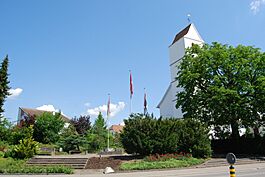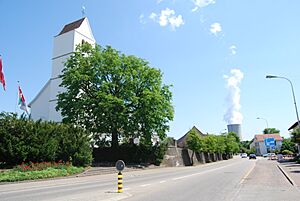Obergösgen facts for kids
Quick facts for kids
Obergösgen
|
||
|---|---|---|
 |
||
|
||
| Country | Switzerland | |
| Canton | Solothurn | |
| District | Gösgen | |
| Area | ||
| • Total | 3.63 km2 (1.40 sq mi) | |
| Elevation | 390 m (1,280 ft) | |
| Population
(Dec 2020 )
|
||
| • Total | 2,359 | |
| • Density | 649.9/km2 (1,683.1/sq mi) | |
| Postal code |
4653
|
|
| Surrounded by | Däniken, Dulliken, Lostorf, Niedergösgen, Winznau | |
Obergösgen is a small town, also called a municipality, located in the Gösgen area of the canton of Solothurn in Switzerland. It's a lovely place by the Aare river.
Contents
A Look at Obergösgen's Past
When Was Obergösgen First Mentioned?
Obergösgen has a long history! It was first written about in official records way back in 1161. At that time, it was called Gozequouon. Later, in 1308, it was known as Göskon superior.
Exploring Obergösgen's Geography
What is Obergösgen Like Geographically?
Obergösgen covers an area of about 3.64 square kilometers (which is about 1.4 square miles). A big part of this land, about 40.7%, is used for farming. Forests cover another 29.4% of the area.
How is the Land Used in Obergösgen?
About 21.2% of Obergösgen's land is developed with buildings and roads. This includes homes, businesses, and streets. Rivers and lakes make up about 8% of the area. A very small part, about 0.5%, is land that isn't used for anything.
Where is Obergösgen Located?
The municipality is situated in the Gösgen district. It sits right along the Aare river, which is a major river in Switzerland. Obergösgen includes the main village and a smaller area called Schachen.
Understanding Obergösgen's Coat of Arms
What Does Obergösgen's Coat of Arms Mean?
A coat of arms is like a special symbol or logo for a town or family. Obergösgen's coat of arms is quite unique! It shows a red background with a silver castle. This castle has two towers, each with a roof and a flag.
Below the castle, there's a green hill with three bumps. On the other side of the shield, there's a wavy blue line on a silver background. This wavy line likely represents the Aare river that flows through the municipality.
Who Lives in Obergösgen? (Demographics)
How Many People Live in Obergösgen?
Obergösgen has a population of about 2,497 people. In 2008, about 21.6% of the people living there were from other countries. Over ten years, from 1999 to 2009, the population grew by about 5.7%.
What Languages Do People Speak?
Most people in Obergösgen speak German. In 2000, about 86.2% of the population spoke German. The next most common languages were Albanian (3.3%) and Italian (2.7%).
Where Are People From?
In 2000, about 26.4% of the people living in Obergösgen were born there. Another 26.2% were born in the same canton (Solothurn). About 26.5% were born elsewhere in Switzerland, and 18.5% were born outside of Switzerland.
How Old Are the Residents?
In 2000, about 7.1% of the population were young children (0-6 years old). Teenagers (7-19 years old) made up about 18.2%. Adults aged 25-44 were the largest group, at 31.4%. About 9.6% of the population were seniors aged 65-79.
What About Households in Obergösgen?
In 2000, there were 792 private households in Obergösgen. On average, there were 2.4 people per household. About 28.6% of households had only one person living in them. There were also many married couples, some with children and some without.
Types of Homes in Obergösgen
In 2000, most of the inhabited buildings in Obergösgen were single-family homes, making up about 70.8% of all homes. There were also multi-family buildings and buildings used for both living and business. Many homes were built between 1946 and 1960.
Apartments and Housing Trends
The municipality had 841 apartments in 2000. The most common size was 4 rooms. Most apartments (92.9%) were lived in all the time. In 2009, new housing was being built at a rate of 14 new homes per 1000 residents.
How Has Obergösgen's Population Changed Over Time?
The chart below shows how the number of people living in Obergösgen has changed throughout history. You can see how the population has grown over the years.

Obergösgen's Economy
What Kinds of Jobs Are There?
In 2010, Obergösgen had an unemployment rate of 4.7%. This means that 4.7% of people looking for jobs couldn't find one. The economy is divided into three main parts:
- Primary Sector: This includes jobs like farming. In 2008, about 20 people worked in this area.
- Secondary Sector: This involves making things, like in factories or construction. About 73 people worked in this sector.
- Tertiary Sector: This is about services, like shops, transport, or education. About 308 people worked in this sector.
How Do People Get to Work?
In 2000, many people who lived in Obergösgen worked outside the municipality. About 19.7% of workers used public transportation, like buses or trains, to get to their jobs. A much larger group, 60.4%, used their own cars.
Religion in Obergösgen
What Religions Are Practiced Here?
According to a 2000 survey, many different religions are practiced in Obergösgen.
- About 41.6% of the people were Roman Catholic.
- About 27.9% belonged to the Swiss Reformed Church.
- Smaller groups included Orthodox Christians, Christian Catholics, and other Christian churches.
- There were also people who were Jewish, Islamic, Buddhist, and Hindu.
- About 13.55% of the population said they didn't belong to any church, or were agnostic or atheist.
Learning in Obergösgen (Education)
What is the Education System Like?
In Obergösgen, many adults have completed higher education. About 38.9% of the population finished non-mandatory high school. About 8% went on to university or a specialized college.
Schools in Obergösgen
During the 2010-2011 school year, there were 157 students in Obergösgen's school system.
- Kindergarten: Young children can attend two years of non-required Kindergarten. There were 41 children in kindergarten that year.
- Primary School: Students must attend six years of primary school. Obergösgen had 116 students in primary school.
- Secondary School: After primary school, students go to three years of required lower secondary school. All Obergösgen students attend this school in a nearby town. After that, there are optional advanced schools.
Students Commuting for School
In 2000, 219 students came to Obergösgen to attend school. At the same time, 47 students from Obergösgen went to schools in other municipalities.
Images for kids
See also
 In Spanish: Obergösgen para niños
In Spanish: Obergösgen para niños






